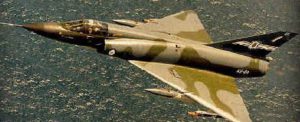 The news that Australia’s new submarine fleet will likely be built largely by the French, with a make-work fitting-out in South Australia no doubt much appreciated by beleaguered Liberals Christopher Pyne, Nicole Flint and Matt Williams, has surprised many while simultaneously intriguing those few souls who follow the byzantine intrigues and currents that so often figure in big-ticket international arms contracts. The latter group tend to have an eye for history and somewhat longer memories than most– two reasons why today’s announcement prompted thoughts of the Mirage jets (above) that were, back in the Sixties, our front-line fighters.
The news that Australia’s new submarine fleet will likely be built largely by the French, with a make-work fitting-out in South Australia no doubt much appreciated by beleaguered Liberals Christopher Pyne, Nicole Flint and Matt Williams, has surprised many while simultaneously intriguing those few souls who follow the byzantine intrigues and currents that so often figure in big-ticket international arms contracts. The latter group tend to have an eye for history and somewhat longer memories than most– two reasons why today’s announcement prompted thoughts of the Mirage jets (above) that were, back in the Sixties, our front-line fighters.
While the submarine decision is picked over, evaluated and debated, an ancient clipping from the Canberra Times might be worth bearing in mind. Here is then-defence correspondent Frank Cranston’s report, as published on May 14, 1979:
Suggestions that France imposed an embargo against Australia using its Mirage fighters during the Vietnam war have been denied at high defence levels in Canberra.
The denials come as a team of RAAF experts is abroad studying four aircraft on its short list of replacements for the Mirages, among them Dassault’s Mirage 2000.
Sweden and Switzerland placed embargoes against the use by Australia of equipment in Vietnam during the war, the Swedes over missiles for the Carl Gustav anti-tank system and the Swiss over one Pilatus Porter aircraft for the Army Aviation Corps.
It was said also in 1968 that France had instructed that the RAAF Mirages not be sent to Vietnam, the threat being that if the order was defied no more ammunition would be supplied for the aircraft’s DEFA guns.
There was in fact no embargo, though the misunderstanding was understandable enough in view of moves which were made at the time.
As it phased out its Avon Sabre jets to make way for the Mirage Ills, the RAAF realised that it had very large stocks of spares and ammunition for the British Aden guns in the Sabres and was interested in using them in its new aircraft.
Both the DEFA arid the Aden were derivatives of the German Mauser design, though the French development had a much greater muzzle velocity.
As the plans were developed to try to install the Aden weapons, a dispute arose with the French over payment of royalties for the manufacture in Australia of DEFA ammunition, spare barrels and other high-use parts in the guns.
The projects to establish that the DEFA could be replaced developed considerable priority, more as a lever against the French in the royalty negotiations than as a practical project. If it had worked, which it did not, it would, of course, have saved many millions of dollars.
During the intervening decade, the French themselves have not drawn attention to the misinterpretation of the facts. However, with the Mirage 2000 in contention for an order which could run up to $2,000 million, some senior defence people believe the matter should be laid to rest.
Apart from serving to remind us how Fairfax once produced decent newspapers, capable of succinct reporting and displaying no need to garnish every report with the editorial input of SJW brats brandishing fresh degrees in queer studies and eco-feminism, the oblique reference in the above excerpt to “moves which were made at the time” might also give pause to all but Liberals occupying federal seats in South Australia.
Those “moves” were the decision by French lawmakers to ban the supply of Mirage parts and ammunition to Israel, along with other war wares that might have come in handy after the 1967 war.
So, if history is any guide, Australia’s next submarines should do just fine — so long as our enemies also happen to be those which France, on any particular day, also holds in low regard.
Via the link below, a 2010 New York Times re-capping of France’s decision to abandon its friend and customer in favour of the Arab states.
— roger franklin
 Sign In
Sign In 0 Items (
0 Items ( Search
Search







